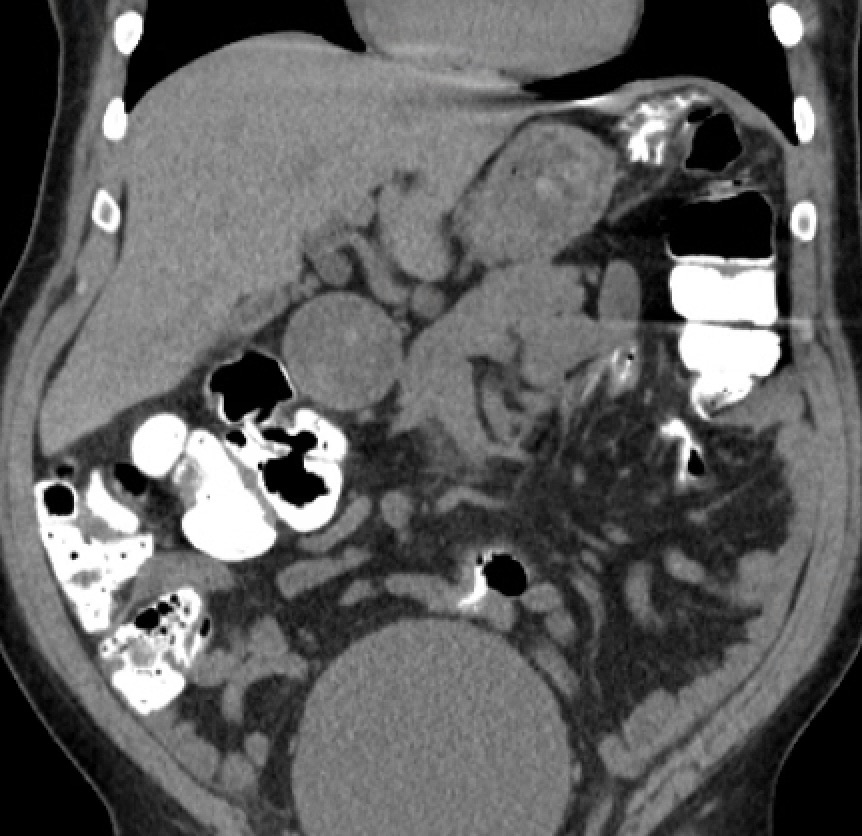Sunday Poster Session
Category: Colon
P0454 - A Bizarre Bezoar Volvulus
Sunday, October 26, 2025
3:30 PM - 7:00 PM PDT
Location: Exhibit Hall
- VD
Victoria Diaz, MD
Sunrise Health GME Consortium
Las Vegas, NV
Presenting Author(s)
Victoria Diaz, MD, Luke Johnson, MD, Mark Hsu, MD, Austin Reed, DO, John Ryan, MD
Sunrise Health GME Consortium, Las Vegas, NV
Introduction: Phytobezoars are an accumulation of indigestible material from seeds or fruit pits which can lead to impaction or even obstruction. Only 0.4-4% of obstructions are caused by bezoars with the most common locations being stomach, followed by small intestine, and most rarely, colon. Herein; we present a case of a rare sunflower seed phytobezoar obstruction in the sigmoid leading to volvulus, another rare occurrence accounting for less than 5% obstructions. Patients suffering from bezoars should be closely monitored for the development of complications until resolution.
Case Description/
Methods: After consuming a considerable amount of sunflower seeds with the shells included, a 60-year-old male presents with left lower quadrant pain and hematochezia. CT showed a distended bowel loop measuring 6.2 cm with a transition point, consistent with sigmoid volvulus secondary to a bezoar measuring 5.5 cm. On DRE, palpable fibrous material was unable to be removed by manual disimpaction. On flexible sigmoidoscopy, a conglomeration of sunflower seed shells was visualized. The volvulus was successfully decompressed; however, despite endoscopic lavage the fibrous debris was unable to be evacuated. The patient had ongoing constipation for five more days despite an aggressive bowel regimen with laxatives and enemas. General surgery was consulted and planned for removal under anesthesia. Gastrografin contrast enema was administered prior to protoscopy which ultimately served to be therapeutic. The patient was able to effectively pass the bezoar before the procedure and bowel function returned.
Discussion: In the presence of gastric acid, cellulose, lignin, and tannin are plant fibers that form the gluelike coagulum of phytobezoars. Patients can present with vague nonspecific symptoms such as abdominal pain, nausea, constipation, and/or rectal pain. It is important when taking history to identify recently ingested foods with associations to forming bezoars. CT is a reliable imaging modality to identify a bezoar, but endoscopy is considered the gold standard as it offers the opportunity for therapeutic interventions. Recognition of phytobezoar obstruction and prompt intervention may prevent complications including ileus, stercoral colitis, bowel ischemia or necrosis, peritonitis, and perforation. Treatment is dependent on case specifics and in uncomplicated cases conservative management with manual disimpaction or enemas is preferred. In cases with complications, more aggressive surgical management is warranted.

Figure: CT A/P with IV contrast coronal view shows distended redundant sigmoid measuring 6.2 cm with transition point consistent with sigmoid volvulus.

Figure: Endoscopic view of sunflower seed phytobezoar in the sigmoid.
Disclosures:
Victoria Diaz indicated no relevant financial relationships.
Luke Johnson indicated no relevant financial relationships.
Mark Hsu indicated no relevant financial relationships.
Austin Reed indicated no relevant financial relationships.
John Ryan indicated no relevant financial relationships.
Victoria Diaz, MD, Luke Johnson, MD, Mark Hsu, MD, Austin Reed, DO, John Ryan, MD. P0454 - A Bizarre Bezoar Volvulus, ACG 2025 Annual Scientific Meeting Abstracts. Phoenix, AZ: American College of Gastroenterology.
Sunrise Health GME Consortium, Las Vegas, NV
Introduction: Phytobezoars are an accumulation of indigestible material from seeds or fruit pits which can lead to impaction or even obstruction. Only 0.4-4% of obstructions are caused by bezoars with the most common locations being stomach, followed by small intestine, and most rarely, colon. Herein; we present a case of a rare sunflower seed phytobezoar obstruction in the sigmoid leading to volvulus, another rare occurrence accounting for less than 5% obstructions. Patients suffering from bezoars should be closely monitored for the development of complications until resolution.
Case Description/
Methods: After consuming a considerable amount of sunflower seeds with the shells included, a 60-year-old male presents with left lower quadrant pain and hematochezia. CT showed a distended bowel loop measuring 6.2 cm with a transition point, consistent with sigmoid volvulus secondary to a bezoar measuring 5.5 cm. On DRE, palpable fibrous material was unable to be removed by manual disimpaction. On flexible sigmoidoscopy, a conglomeration of sunflower seed shells was visualized. The volvulus was successfully decompressed; however, despite endoscopic lavage the fibrous debris was unable to be evacuated. The patient had ongoing constipation for five more days despite an aggressive bowel regimen with laxatives and enemas. General surgery was consulted and planned for removal under anesthesia. Gastrografin contrast enema was administered prior to protoscopy which ultimately served to be therapeutic. The patient was able to effectively pass the bezoar before the procedure and bowel function returned.
Discussion: In the presence of gastric acid, cellulose, lignin, and tannin are plant fibers that form the gluelike coagulum of phytobezoars. Patients can present with vague nonspecific symptoms such as abdominal pain, nausea, constipation, and/or rectal pain. It is important when taking history to identify recently ingested foods with associations to forming bezoars. CT is a reliable imaging modality to identify a bezoar, but endoscopy is considered the gold standard as it offers the opportunity for therapeutic interventions. Recognition of phytobezoar obstruction and prompt intervention may prevent complications including ileus, stercoral colitis, bowel ischemia or necrosis, peritonitis, and perforation. Treatment is dependent on case specifics and in uncomplicated cases conservative management with manual disimpaction or enemas is preferred. In cases with complications, more aggressive surgical management is warranted.

Figure: CT A/P with IV contrast coronal view shows distended redundant sigmoid measuring 6.2 cm with transition point consistent with sigmoid volvulus.

Figure: Endoscopic view of sunflower seed phytobezoar in the sigmoid.
Disclosures:
Victoria Diaz indicated no relevant financial relationships.
Luke Johnson indicated no relevant financial relationships.
Mark Hsu indicated no relevant financial relationships.
Austin Reed indicated no relevant financial relationships.
John Ryan indicated no relevant financial relationships.
Victoria Diaz, MD, Luke Johnson, MD, Mark Hsu, MD, Austin Reed, DO, John Ryan, MD. P0454 - A Bizarre Bezoar Volvulus, ACG 2025 Annual Scientific Meeting Abstracts. Phoenix, AZ: American College of Gastroenterology.
